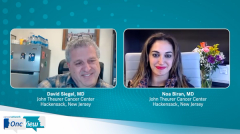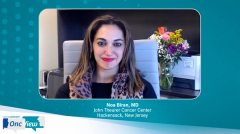
MM Therapies: Bispecific Antibodies and T-Cell Engagers
A comprehensive discussion on bispecific antibodies and T-cell engagers in the treatment of multiple myeloma.
Episodes in this series

Transcript:
Noa Biran, MD:Sometimes we run into issues where patients don’t make it to their infusion of CAR [chimeric antigen receptors]T cells, either because their disease progresses too rapidly or they develop infections, or sometimes the T cells aren’t produced effectively because of the incompetent pool of T cells. We have a lot of barriers for patients to receive this therapy. Yes, it’s feasible, and we’ve learned after using it for a while how to select the right patient for this treatment. But we’re also lucky in that we have alternatives for patients who may have rapidly progressing disease or may not be candidates for CAR T. And those are bispecific antibodies. Maybe we can spend a few minutes talking about the first FDA-approved bispecific antibody, and then novel bispecific T-cell engagers that are in development. Do you want to talk a little bit about teclistamab?
David Siegel, MD: The first thing is to explain what a bispecific antibody is and that at its simplest, we can create antibodies that will bind to almost anything. We talked about unique targets on myeloma cells. One of those unique targets is BCMA [B-cell maturation antigen]. We have created—we meaning the whole medical industry—antibodies against BCMA. You can take that antibody, give it to a patient, and it will bind to BCMA.
The problem with CAR T cells that Noa just described is that sometimes it’s hard to do that; you don’t have enough time. So what you can do is produce a second antibody that actually binds to T cells. There are a number of targets on T cells that are useful. The one that has been chosen [currently] is called CD3. All T cells are the cells in our body that are capable of killing cancer cells. They are also capable of killing virally infected cells and things like that. So you can take an antibody that on one end binds to the cancer cell BCMA. The other end binds to the T cell and, basically, physically, pulls those 2 guys together. T cells are very irritable. And when you drag them onto something that they’re not comfortable being dragged on to, they say, “I’m going to kill you.” And that’s what they do. That’s what bispecific antibodies are.
The first to be approved is called teclistamab. One side binds BCMA. One side binds CD3. You drag those 2 guys together and, hopefully, the T cell wins. And it turns out that most of the time it does. Teclistamab is the first of these T-cell engagers to get approved in multiple myeloma [MM], although there are many on the way.
Noa Biran, MD: I think teclistamab certainly has its drawbacks, which we can talk about. But, just in general, [I think] it has really changed the standard of care in terms of what we expect for response rates. Previously, it’s been published more retrospectively that patients who are refractory to the 3 most common classes of drugs have very, very poor survival, measured in months—perhaps 6 to 8 months—and have response rates for novel therapies of 30%. And other therapies have been approved in this patient population based on a 30% overall response rate. Teclistamab has shown more than double that overall response rate. And that’s with a single agent. No steroids, just the drug alone.
It’s a subcutaneous injection. You have to give it in step-up dosing. So start with a low dose and slowly build up to prevent or minimize the risk of cytokine release syndrome, which is when your cytokines are quickly proliferating and can cause fevers, low blood pressure, and shortness of breath. We’ve kind of changed what we expect for a standard of care in these patients.
The downside that we need to think about with teclistamab and perhaps with similar drugs of the same class is the risk of infection. Unfortunately, the T cells are being harnessed to fight myeloma. And we see a depletion in the healthy T cells, similar to what we saw with patients who were HIV positive or [patients with] AIDS. So we see many of those opportunistic types of infections that we weren’t seeing for a very long time. And [patients had] difficulty clearing viruses, common colds, and parainfluenza. COVID-19 clearance takes much, much longer, and [there is] frequent pneumonia. Most of these infections are not severe, but many of them are. And we have to think about which patient we choose for these types of treatments because we don’t know what the long-term outcomes are going to be in terms of infection risk with these patients.
David Siegel, MD: Risk mitigation is always a big part of medicine. What can we do to make the things that we have safer? And if they’re safer, they’re often more effective. We can use them better. We’ve already started to realize that these drugs are so effective that you probably don’t need to use them continuously. To say, OK, instead of keeping you on these potentially risky drugs indefinitely, let’s just do it for a short period of time, get your disease under control, and perhaps watch and not cause as much disruption to your immune system.
I read a paper recently, not about myeloma, but about lymphoma. It showed that one of the drugs that we use very, very widely in the treatment of myeloma, Revlimid [lenalidomide], improves the efficacy of CAR T cells and perhaps T-cell engagers in the treatment of lymphoma. So it may turn out that we’ll be even more lucky because that drug, [lenalidomide], does 2 different things. No. 1, it activates immune cells. It makes the cells that kill cancer cells more active—NK [natural killer] cells, T lymphocytes, a variety of cells. But it also is really good at killing myeloma and making the myeloma cell weaker.
Perhaps as we learn our craft a little bit better, the combinations of drugs like that with these really cool tools will make them way more effective and allow us to do less and gain more, and, therefore, not compromise our immune system quite as much. It’s a really cool time. We just need to figure out exactly what we’re doing. The technologies have run so fast that the best way to do things is just being learned now.
Noa Biran, MD: And we’re going to learn a lot of that quickly because we have so many ongoing trials looking at different combinations, looking at fixed-duration therapy.
Transcript edited for clarity.
Newsletter
Stay up to date on recent advances in the multidisciplinary approach to cancer.



















































































